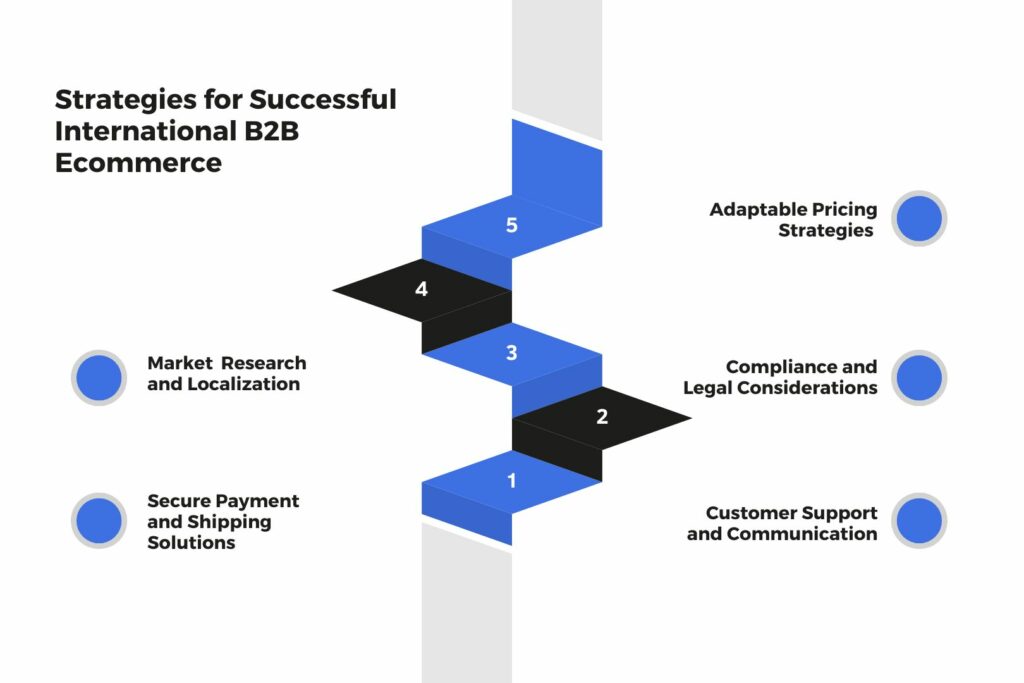Expanding horizons and reaching global markets have never been easier than in today’s digital age. With the rise of B2B e-commerce, businesses are now empowered to sell their products and services internationally, breaking down geographical barriers and tapping into a world of opportunities. In this blog, we will delve into the exciting realm of international B2B e-commerce and explore the strategies, benefits, challenges, and best practices associated with selling internationally.
Product options from around the world can be easily explored via the internet. According to a recent Forrester study, almost three quarters of B2B buyers will research half of their work purchases online. Currency is no longer a barrier with international transactions through Authorize.net, Google Checkout, Amazon Payments and PayPal – to name just a few.
But there’s much more to international selling and global B2B. Many manufacturers, distributors and wholesalers could be overlooking important opportunities and risks of global competition.
Table of Contents
The Global Landscape of B2B E-Commerce
The landscape of B2B e-commerce has witnessed a remarkable transformation in recent years. While B2B transactions were traditionally conducted through phone calls, faxes, and in-person meetings, businesses are now embracing the digital revolution. The convenience, efficiency, and scalability of online platforms have revolutionized the way B2B transactions take place, opening up vast possibilities for expansion beyond local markets.As a business to business (B2B) ecommerce company, you are already competing in an international market.

Moving to the Cloud
For many companies, an expanding international B2B business means a new ecommerce platform.
customizing and integrating existing systems to support multiple countries or channels is often costly and time-consuming. In many cases, these systems can quickly become bottlenecks for your expansion plans.
Moving to the Cloud is an increasingly popular solution to these problems. It is often driven by the need to add versatile features such as catalogue management, multiple online storefronts, local partner portals, configure-price-quote (CPQ) and payment gateways and payment options to support a multinational business.
Cloud-based B2B ecommerce platforms like Cloudfy can be easily configured and integrated with major business systems. They can also support complex sales workflows, management of multiple channels and fulfillment systems.
To future-proof your growing business, you can also be confident that a Cloud-based solution is scalable and can support your innovative new business models. With continual updates automatically delivered, it is also easier to maintain and keep ahead of the competition.
The Amazon factor
Launched in America in 2015, Amazon Business arrived in the UK in April this year and is one of the most important online marketplaces out there. Amazon Business aims to meet the buying needs of all sizes of business and institutions such as universities, hospitals and charities. It is likely to have a major impact on cross-border purchasing.
We recommend any B2B business consider their own B2B Ecommerce portal rather than Amazon to maintain independence and control of their customer relationships. Amazon Business may be an additional route to market but poses some business risk if it were to be the only route to market. Not all products are suitable for sale on Amazon.
A strategic approach to creating an outstanding brand experience on your site will make you stand out and contribute to long-term customer loyalty. In addition to carefully designed user journeys and stunning pages, an extended product range, additional product information and value added services will all attract customers to your site.
Smartphone penetration in the UK increased to 81% in 2016. These devices have overtaken laptops and are influencing buying behavior in the workplace. Your international strategy will need to handle ordering from any device, anywhere and at anytime.
Language, currency and shipping requirements can be intelligently pre-populated on your site, but will need to be flexible enough to allow your B2B customers to change according to their needs.
You will also need to consistently manage prices and promotions in different countries and take a business-wide view of cross-border selling.
Your buyers might be happy with self-service in their busy work schedule. If they decide to send emails or call, your customer support team will need to seamlessly match their online experience and fully understand their local requirements.
You can also complement these efforts by utilizing digital marketing and social media campaigns. This can allow you to reach more customers, promote your products and services, and expand your presence in the B2B market. And don’t neglect things like customer service and enabling positive customer experiences and user experiences.

Benefits of Selling Internationally with B2B E-Commerce
Selling internationally through B2B ecommerce expands market reach, enabling access to a global customer base. It facilitates efficient cross-border transactions, reduces geographical limitations, and fosters business growth. Some of the major benefits are as follows:
Expanded Market Reach
One of the most significant advantages of international B2B e-commerce is the access it provides to a global customer base. Businesses can showcase their products and services to a diverse audience, transcending geographical limitations and time zones.
Increased Revenue Potential
By venturing into international markets, businesses can tap into new streams of revenue. Different regions may have varying demands and needs, allowing businesses to diversify their product offerings and maximize their sales potential.
Cost-Efficiency
Compared to traditional brick-and-mortar expansions, international B2B e-commerce offers a cost-effective way to enter new markets. The need for physical storefronts and local infrastructure is significantly reduced, enabling businesses to allocate resources more strategically.
Enhanced Customer Insights
Operating on a global scale exposes businesses to valuable customer insights from various regions. This data can be used to fine-tune marketing strategies, tailor offerings, and improve overall customer experience.
Improved Customer Experience
B2B e-commerce platforms provide customers with the convenience of browsing and placing orders at any time. Additionally, personalized digital experiences can be tailored to different regions, languages, and cultures, enhancing customer satisfaction.
Strategies for Successful International B2B E-Commerce
Implement localized marketing and user-friendly interfaces while navigating regulatory complexities to establish trust and drive cross-border sales in international B2B ecommerce. Some of the strategies are as follows:
Market Research and Localization
Before expanding internationally, conducting thorough market research is paramount. Understanding cultural preferences, regulatory requirements, and local competition can help tailor offerings to suit each market. Localization, including language translation and cultural adaptation, is essential to resonate with diverse audiences.
Secure Payment and Shipping Solutions
International transactions necessitate reliable and secure payment gateways that support various currencies. Moreover, establishing efficient shipping and logistics solutions is vital to ensure timely delivery and customer satisfaction across borders.
Adaptable Pricing Strategies
Different regions may have varying economic conditions and price sensitivities. Implementing dynamic pricing strategies that consider local factors can optimize sales and competitiveness.

Navigating international markets requires adherence to diverse legal and regulatory frameworks. Businesses must ensure compliance with taxes, customs, data protection, and other relevant regulations in each market.
Customer Support and Communication
Effective communication is key to building trust with international customers. Providing multilingual customer support and clear communication about product information, shipping, and returns policies can bridge the gap between businesses and their global clientele.
Challenges to Overcome hurdles in International B2B Ecommerce
While the opportunities of international B2B e-commerce are abundant, businesses must also address certain challenges:
Cultural Differences
Cultural nuances can impact how products are perceived and marketed. Businesses must be sensitive to cultural differences in messaging, imagery, and branding.
International shipping involves complexities such as customs clearance, duties, and varying delivery times. Businesses need to partner with reliable logistics providers to ensure seamless operations.
Regulatory Compliance
Navigating diverse regulations, including trade restrictions and tax policies, can be intricate. Legal experts and consultants can help businesses remain compliant in different markets.
Payment and Currency Issues
Handling multiple currencies and payment methods demands robust payment processing systems to avoid errors and discrepancies.
Best Practices for Success of International B2B E-Commerce
Some of the best practices for success are as follows:
Start Small and Scale
Entering multiple international markets simultaneously can be overwhelming. It’s advisable to start with a focused approach, targeting a few key markets and then expanding gradually.
Build Strong Partnerships
Collaborating with local distributors, agents, or partners can provide businesses with invaluable insights into the local market, helping them navigate challenges effectively.
Prioritize Customer Experience
Exceptional customer experience transcends borders. Ensuring a seamless and personalized online journey, from browsing to post-purchase support, can foster loyalty among international customers.
Invest in Technology
A robust B2B e-commerce platform equipped with internationalization features is crucial for managing multiple markets efficiently. This includes multi-language support, regional pricing, and adaptive user experiences.
Stay Agile and Adaptable
International markets are dynamic, and strategies that work in one region might need adjustment in another. Flexibility and the ability to learn from experiences are vital to success.
In Conclusion
Selling internationally with B2B e-commerce opens up a world of opportunities for businesses. It allows them to transcend geographical limitations, tap into diverse markets, and capitalize on a global customer base. With careful planning, adaptation to cultural nuances, and a commitment to providing exceptional customer experiences, businesses can navigate the challenges and reap the rewards of international expansion. As technology continues to evolve, the landscape of international B2B e-commerce will only become more exciting, dynamic, and full of potential.
If your company is going global then contact us today to find out more about international B2B ecommerce marketing, selling and more.
Frequently Asked Questions
The rise of B2B e-commerce has revolutionized international business transactions by providing businesses with efficient, convenient, and scalable platforms. This enables them to expand beyond local markets and connect with global customers more easily.
International B2B e-commerce offers several benefits, including expanded market reach, increased revenue potential, cost-efficiency, enhanced customer insights, and improved customer experience. It allows businesses to tap into diverse markets and maximize their sales potential.
Successful international B2B e-commerce strategies include thorough market research and localization, secure payment and shipping solutions, adaptable pricing strategies, compliance with regulations, and effective customer support and communication.
Businesses selling internationally with B2B e-commerce may encounter challenges such as cultural differences, logistics and shipping complexities, regulatory compliance issues, and handling payment and currency matters.
Prioritizing customer experience involves providing exceptional support, personalized online journeys, and clear communication about product information and policies. It's important to bridge the gap between businesses and their international customers.
Starting small and scaling allows businesses to focus their efforts on a few key markets, understand customer preferences and challenges, and gradually expand their reach. This approach minimizes the risk of overwhelming complexity in multiple markets.
Investing in a robust B2B e-commerce platform with internationalization features is crucial for managing multiple markets efficiently. Technology enables businesses to offer multi-language support, regional pricing, and adaptive user experiences.
As technology evolves, international B2B e-commerce will become even more dynamic and full of potential. Businesses that adapt to changing trends, regulations, and customer preferences will continue to thrive in the global market.






